Papers by Prof. Abdul Al Lily
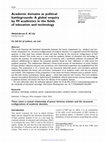
This article theorizes the functional relationship between the human components (i.e., scholars) ... more This article theorizes the functional relationship between the human components (i.e., scholars) and non-human components (i.e., structural configurations) of academic domains. It is organized around the following question: in what ways have scholars formed and been formed by the structural configurations of their academic domain? The article uses as a case study the academic domain of education and technology to examine this question. Its authorship approach is innovative, with a worldwide collection of academics (99 authors) collaborating to address the proposed question based on their reflections on daily social and academic practices. This collaboration followed a three-round process of contributions via email. Analysis of these scholars' reflective accounts was carried out, and a theoretical proposition was established from this analysis. The proposition is of a mutual (yet not necessarily balanced) power (and therefore political) relationship between the human and non-human constituents of an academic realm, with the two shaping one another. One implication of this proposition is that these non-human elements exist as political 'actors', just like their human counterparts, having 'agency' – which they exercise over humans. This turns academic domains into political (functional or dysfunctional) 'battlefields' wherein both humans and non-humans engage in political activities and actions that form the identity of the academic domain. For more information about the authorship approach, please see Al Lily AEA (2015) A crowd-authoring project on the scholarship of educational technology. Information Development.
The author was the mediator of a two-year project wherein 100 academics from around the world col... more The author was the mediator of a two-year project wherein 100 academics from around the world collaborated electronically, over three rounds, on the composition of a multi-authored manuscript. In this article, he relies on this international experience to promote various ideas that could help democratise academic authoring and publishing activities. These ideas help rethink academic journals from the perspective of ‘socialism’, promoting social ownership of academic journals and social participation in the shaping of their policies.

Academic cognition and intelligence are ‘socially distributed’; instead of dwelling inside the si... more Academic cognition and intelligence are ‘socially distributed’; instead of dwelling inside the single mind of an individual academic or a few academics, they are spread throughout the different minds of all academics. In this article, some mechanisms have been developed that systematically bring together these fragmented pieces of cognition and intelligence. These mechanisms jointly form a new authoring method called ‘crowd-authoring’, enabling an international crowd of academics to co-author a manuscript in an organized way. The article discusses this method, addressing the following question: What are the main mechanisms needed for a large collection of academics to collaborate on the authorship of an article? This question is addressed through a developmental endeavour wherein 101 academics of educational technology from around the world worked together in three rounds by email to compose a short article. Based on this endeavour, four mechanisms have been developed: a) a mechanism for finding a crowd of scholars; b) a mechanism for managing this crowd; c) a mechanism for analyzing the input of this crowd; and d) a scenario for software that helps automate the process of crowd-authoring. The recommendation is that crowd-authoring ought to win the attention of academic communities and funding agencies, because, given the well-connected nature of the contemporary age, the widely and commonly distributed status of academic intelligence and the increasing value of collective and democratic participation, large-scale multi-authored publications are the way forward for academic fields and wider academia in the 21st century.
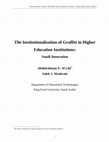
This article is informed by the Fun Theory, a theory that calls for the institutionalisation of f... more This article is informed by the Fun Theory, a theory that calls for the institutionalisation of fun in social settings. It highlights how the academic and non-academic literature shows some individuals to find the practice of graffiti to be fun. It then attempts to build an empirical framework for the idea of institutionalising this fun practice in the social settings of the higher education sector. It addresses the research question: To what extent does the institutionalisation of graffiti in the societal culture of higher education institutions enhance public expression among members through their reflection on daily social and academic life? This question was addressed by a semester-long experiment, wherein graffiti was incorporated into the day-to-day social activity of a Saudi public university, by officially allocating certain walls that members could legally write upon and, further, draw whatever they wanted. The experiment appeared to be fruitful in the sense that the allocated walls were full of writings and drawings, enabling and promoting among members a sense of public articulation based on consideration of their own daily academic and social experience. Thus, it could be suggested that the Fun Theory in general and the institutionalisation of graffiti in particular could hold value for organisations in general and for higher education institutions in particular.
This article investigates the possibility that many users of the mobile phone communication apps ... more This article investigates the possibility that many users of the mobile phone communication apps communicate with one another but do not necessarily convey or receive any information, that is, anything that informs. A qualitative and quantitative investigation was carried out in Saudi Arabia, looking at how informative the messages were that Saudi society exchanged over mobile phone communication apps. The main finding was that a large number of the messages exchanged among Saudi users conveyed no actual information or only trivial information. In other words, with the increasing ease of digital communication, users may overuse technology merely to communicate for the sake of communication, with no interest in actually being informed by anything, thus suffering from “information thinness.”

This article spans the domains of education, technology and geo-politics. It uses as an instance ... more This article spans the domains of education, technology and geo-politics. It uses as an instance the Arab scholarship of education and technology, viewing its scholarly community through the geographical lens of regionalism. It enquires into the power relations among scholars in the Arab region and between scholars in the Arab region and their fellows from outside the region. It addresses the research question: to what extent have region-informed factors affected the scholarly community of education and technology in the Arab region? This question was answered by both qualitative and numerical enquiry, analysing documents, interviews and a survey of native Arabic-speaking scholars. Having analysed the data using the grounded theory approach, two categories of power relations among scholars were identified: power relations within a particular region and power relations across regions. Considering these two categories, a theoretical proposition could be posited that there could be power relationships among scholars that exist on a regional basis. The recommendation is therefore that research should further shed light upon the regionalistic (and thus geographically informed political) dynamics of scholarly communities.
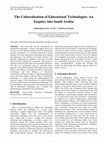
The Culturalisation of Educational Technologies: An Enquiry into Saudi Arabia, 2014
This work looks into the culturalisation of educational technologies, a subject that appears thus... more This work looks into the culturalisation of educational technologies, a subject that appears thus far to not have received sufficient attention from the international academic community. It is structured around the research question: How have educational technologies been exposed and subjected to the influence of societal cultures? This question is addressed by a qualitative case study of a Saudi state university, analysing its documents, interviewing its members and observing its daily social-academic dynamics. The data were interrogated using the grounded theory approach. This method of analysis thus singled out two main themes: The Influence of Societal Cultures on Educational Technologies and The Influence of Educational Technologies on Societal Cultures. A theoretical proposition arises from these themes; that the field of educational technology is a fertile ground for anthropological and historical enquiry, with possibilities for mutual feedback between societal cultures and educational technologies. The recommendation is that researchers and commentators in the field of educational technologies seek to benefit from anthropological and historical ways of thinking.

Who Controls Whom? History and Educational Technologies, Jul 13, 2015
Considering the lack of research on the historisation of educational technologies, the current st... more Considering the lack of research on the historisation of educational technologies, the current study attempts to fill this void. To do so, the following research question is posed: To what extent have educational technologies and local histories controlled one another? Data for this question came from a naturalistic enquiry into a university in the Saudi Arabian public sector. Having analysed documents, interviews, and observations by means of the grounded theory technique, two key themes emerged: local histories controlling educational technologies and educational technologies controlling local histories. The consideration of both themes brought forth a theoretical proposition — that there are political dynamics between educational technologies and micro histories, with one continuously directing and driving the other. The recommendation is therefore that policymakers, scholars, and commentators should be more cognisant of the political tensions between local histories and educational technologies.
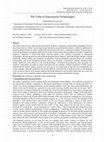
The Tribe of Educational Technologies, May 28, 2014
This article looks into the claim that the international academic community of educational techno... more This article looks into the claim that the international academic community of educational technologies seems to have functioned in a “tribal” way, having formed themselves around tribe-like patterns. It therefore addresses the research question: What are these claimed tribe-like practices that such a community exhibits? This question is answered qualitatively, examining empirically the habits of three Saudi Arabian Bedouin real tribes, followed by empirical comparison of these tribal habits with the habits of the academic community of educational technologies. Having analysed the data using the grounded theory approach, three key themes emerged: Cultural Similarities between Tribes and Academic Communities; Political Similarities between Tribes and Academic Communities; and Social Similarities between Tribes and Academic Communities. Having considered these themes collectively with reference to the existing literature, a theoretical proposition has been grounded: that academic communities are similar to tribes in the sense that all, naturally, constitute themselves in ethnic groups characterised by distinct cultural, political and social norms. The implication is thus that such communities are, at least partially, culturally, politically and socially different. Echoing such an implication, the recommendation is not to seek to remove such cultural, political and social differences and therefore make them act as one, but rather to foster cross-community cultural, political and social exchange and therefore learning.
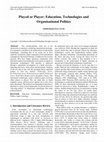
This interdisciplinary work lies at the intersection of education, technology and political socio... more This interdisciplinary work lies at the intersection of education, technology and political sociology. It is intended to contribute to the politicisation of educational technologies, something that so far seems not to have explicitly constituted a major component of the international contemporary theoretical literature. It addresses the research question: How have higher education components acted politically (and/or been politically acted upon) in relation to educational technologies? This question is addressed through a naturalistic investigation of a Saudi university, analysing interviews, observations and documents. Analysis of the raw data in line with the grounded theory approach pointes to four key themes: Politicising Actors, De-Politicising Actors, Politicised Actors and De-Politicised Actors. From these themes can be grounded a theory: that educational technologies entail a political game involving either players or played. This can imply that, in Saudi academic circles, political power appears not to have been fairly distributed. The political recommendation therefore is that there is a need, at least temporarily, for prioritisation of a ‘left-wing politics’ of educational technologies that seeks political fairness.
The social shaping of educational technologies in Saudi Arabia: An examination of how the social fabric shapes the construction and use of technologies, Aug 2013

Social Change and Educational Technologies: By Invitation or Invasion, Nov 12, 2013
This empirical research looks into the theoretical supposition that the social fabric can be shap... more This empirical research looks into the theoretical supposition that the social fabric can be shaped by educational technologies. It addresses the research question: how (and why) has the introduction of educational technologies into higher education institutions influenced the social configuration? This is answered through a qualitative case study of a Saudi state university, based on analysis of interviews, observations, and documents. Data analysis underpins the supposition of the study, demonstrating that the introduction of educational technologies into a university, for good or ill, deliberately or unintentionally, can engender changes in social structures, practices and relations. The recommendation for policy action, therefore, is that, given the technologically-shaped nature of society, the planning and development process of educational technologies should be more participatory, with all different categories of actors being involved and in turn able to express feelings, articulate needs, and negotiate interests. This process should be intended to arrive at a fuller understanding of these groups’ needs, thus overcoming what technologically constrains them and therefore ensuring that the technological shaping of society does not oppress the affected public.
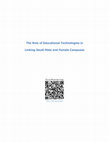
The Role of Educational Technologies in Linking Saudi Male and Female Campuses, Nov 2012
This empirical study examines the role of educational technologies in connecting male and female ... more This empirical study examines the role of educational technologies in connecting male and female university campuses in Saudi Arabia. In order to do so, it addresses the research question: What are the outcomes, ramifications and implications of the ways in which educational technologies have been employed to reconfigure social relations between male and female campuses in Saudi Arabia? This question is answered by a naturalistic study of a state university in the Eastern Province of Saudi Arabia, based on analysis of interviews, observations and documents. From an analysis of the data following the guidelines of the grounded theory technique, two themes emerged: (a) the influence of social relations on the way educational technologies are developed and used, so as to sustain certain aspects of the social structure; (b) the reciprocal influence of the technologies so developed and used on other aspects of the social structure. Considering both themes leads to a theoretical proposition that educational technologies might be introduced to preserve particular components of the social configuration, although once introduced, these technologies might impinge in return upon other components of the social configuration.
On line and under veil: Technology-facilitated communication and Saudi female experience within academia, Feb 2, 2011
The Saudi female population, which is characterised as sheltered, hard-to-reach and conservative,... more The Saudi female population, which is characterised as sheltered, hard-to-reach and conservative, is arousing good interest globally (and nationally). Therefore, a review of literature on emerging issues surrounding Saudi female experience is timely. This article, in the form of a literature review, provides a background to and justification for a forthcoming study, which will examine how technology-facilitated communication has shaped the social–cultural pattern of Saudi female experience within academia.
Books by Prof. Abdul Al Lily

Este trabajo contiene una serie de normas entendidas como directrices para vivir y comportarse co... more Este trabajo contiene una serie de normas entendidas como directrices para vivir y comportarse correctamente entre los Saudís y/o para entender su cultura. La mayoría de éstas reglas han estado durante mucho tiempo sin escribirse y solo verbalmente comunicadas de uno a otro. Como resultado, visitantes de Arabia Saudita no han sido capaces de seguir estas reglas de manera apropiada. Aquellos interesados en los Saudís o en su civilización han informado no comprender ni reconocer estas normas. Por tales razones, estas reglas deben ser deletreadas en negritas. Esta publicación se ha escrito para responder a esta necesidad, así como para informar al púbico en general sobre la naturaleza de los roles de géneros y las relaciones en este país. Cada cultura se rige por un código de conducta interno, y este trabajo ofrece el primer código escrito de la sociedad Saudí. Es el producto de observaciones cercanas a las actividades diarias y más de 2,000 entrevistas con nacionales y residentes, durante los últimos cuatro años. Este código muestra 666 (muchas veces no registradas anteriormente) normas de cómo el cuerpo humano debe actuar dentro de Arabia Saudita. Cubre todo de arriba hasta abajo; el rostro, ojos, oídos, boca, extremidades y genitales. Estas reglas deben ser cuidadosamente consideradas si alguien desea estar dentro del circulo de los Saudís. Para facilitar la lectura, este libro es presentado ‘enlistado’ (una pieza de escritura presentada en forma de una lista numerada o con viñetas).

In the social sciences, although individual and small group forms of authorship are the norm duri... more In the social sciences, although individual and small group forms of authorship are the norm during the authoring process, authoring is merely one phase of the overall ‘cycle’ of academic knowledge production. This authoring phase is normally not collective, whereas many other phases of this cycle are collective; from conferences and seminars, to citation conventions and evaluation processes of all kinds (including peer reviewing). In other words, in the social sciences, most components of academic knowledge production are collective; however, when it comes to authoring, collectivism disappears. This book proposes what could be called ‘crowd-authoring’ – an approach in which a global large group of academics work together to co-author a manuscript. It examines if it is technically and politically feasible to compose a crowd-authored article. It reports on an experiment wherein 99 scholars with shared interest collaborated in three rounds via email to write a short piece. Despite the practical and political challenges, it was found that crowd-authoring could be put into practice. That is, after two years of mediation, this manuscript was completed and submitted for publication. That said, the editors of almost 50 journals rejected the manuscript, without even the consultation of peer reviewers. So, although the process of crowd-authoring was, in itself, successful in the sense that a crowd of authors managed to get together and produce a crowd-authored manuscript, the act of getting editors to tolerate the idea of crowd-authoring was unsuccessful. So, the problem was not with getting academics to manufacture a crowd-authored manuscript but rather with getting editors to respond positively to such a change in the intellectual and procedural convention of authoring. Despite this constant rejection, the manuscript was eventually accepted for publication in a credited, impact-factor journal. This volume recounts and critically reflects on every feature of such an occurrence. A contribution of this volume is that it provides a debate about the technical and political ramifications of crowd-authoring; a phenomenon that is expected to soon enter the academic discourse in the social sciences.

Every culture is governed by an internal code of conduct, and this publication offers the first w... more Every culture is governed by an internal code of conduct, and this publication offers the first written code of Saudi culture. The Saudi way of being has long been an oral tradition passed merely verbally from one generation to the next, despite its power to regulate every aspect of public and private lives. Most Saudi norms and values have long been unwritten and only orally communicated among Saudis. As a result, visitors to Saudi Arabia have been unable to read about Saudi norms and values. For this reason, this book spells out these norms and values in bold print, recording the Saudi code of conduct and displaying it in a published format. It displays 1234 bite-sized (often previously unrecorded) explanations of how the human body acts in Saudi Arabia. It describes ‘the Saudi’ from head to toe: the face, cheek, hair, eyes, skin, brain, mouth, ears, nose, stomach, waist, heart, genitals and extremities. It is the product of close observations of everyday activities and around 2,159 interviews with nationals and residents, over the past six years. This is the first Saudi study to be based on such a generous number of interviews.
This book is the first to talk about Saudi culture in a purely descriptive (and thus non-judgemental and unbiased) manner. It is a ‘snapshot’ of Saudi culture. It is the first to present Saudi values and norms in the form of a bullet-pointed list and in bite-sized explanations. Most of these explanations can be read independently of the other explanations. The way the content is focussed on bite-sized statements is intended to put across clearly and simply the information. The book is the first to be written by a male Saudi who was born and raised in Saudi Arabia, who is still based in this country, who is a former officially-recognised ‘imam’ (i.e. a worship leader) and who comes from a working-class family—yet he is a backpacker, has been with non-Saudis, non-Arabs and non-Muslims from different ethnicities, has studied in Oxford, has published with the largest international academic publishers, has written in different languages and hence has the ability to communicate with international readers and convey information to foreign mentalities.
Publications about Saudi culture tend to be too serious. This book is, however, meant not to be taken too seriously. It is, rather, intended to be entertaining and humorous (and, surely, informative). It tries to avoid the use of the words ‘religion’ and ‘politics’ because of two main reasons. First, these two words are sensitive and, more importantly, serious. Second, the book is purely cultural and written entirely for the sake of cultural exchange (not for religious or political matters). This book is unbiased, exposing both negative and positive practices in Saudi society. Many Saudi readers of the book have criticised the author for not trying to invite (through the book) non-Muslim readers to Islam. Yet, this book is written purely for the sake of international communication (not for religious reasons), with neither religious nor political agendas.
The book covers only what is normal (i.e. norms and long-established practices) in Saudi Arabia–––it does not cover those emerging and changing liberal practices and outliers. Abnormal practices lie beyond the scope of the book. This book is associated mainly with the eastern and middle areas of Saudi Arabia. Besides, the Bro Code varies from one region to another; so its explanations do not apply to every single region in Saudi Arabia, but they do definitely constitute the norm in, at least, one region. This book is not intended to describe Saudi culture in comparison with other traditions, but rather to describe Saudi culture on its own.
Journal Articles by Prof. Abdul Al Lily

Academia is expected to act as a cognitive arena in which members intellectually challenge one an... more Academia is expected to act as a cognitive arena in which members intellectually challenge one another, problematize social structures, and destabilize dominant ideologies. It is, supposedly, a cognitively unstable environment wherein intellectualism pushes social boundaries and acts as an agent for social change. It is a training camp wherein people come to be trained in the practice of critical thinking. Hence, one would imagine that academia would be the last place to find passive conformism. However, does this image reflect reality? Having interviewed four groups of 50 students, 47 academics, and 28 support staff in three Saudi universities, passive conformism (be it unethical, managerial, or in the form of logistical conformism) appears to be a necessity in Saudi academia. This suggests that, although academia acts as an authority in regard to critical thinking, it may not internalize this philosophy or expose its own organizational activities to such thinking. Passive conformism in Saudi academic organizations is enhanced by wider Saudi culture which promotes conformism among its citizens and directs every aspect of public and private lives, including the lives of its academic organizations. A theoretical proposition could be therefore that passive conformism in a society could be transmitted to its organizations.

Traditional perspectives have envisaged intelligence as one entity dominated by a single set of a... more Traditional perspectives have envisaged intelligence as one entity dominated by a single set of abilities (i.e. cognitive abilities), whereas modern perspectives have defined intelligence in various shapes (e.g., linguistic, musical and interpersonal intelligences). By the same token, traditional perspectives have examined stupidity as one set of inabilities (i.e., cognitive inabilities). However, it is not clear if modern perspectives have discussed whether stupidity exists in various forms—in the same way as they have envisaged intelligence. To address this limitation, 257 university members were asked to share what they perceived as being stupid educational and technological practices in their institutions. Analysis of the data suggested three concepts were important to the members: moral, spatial and administrative stupidities. That is, stupidity is perceived to come in the form of failing to meet certain moral, spatial and administrative values. This implies that modern perspectives may conceptualise stupidity differently from traditional perspectives, seeing it as going beyond cognitive inabilities and viewing it as existing in various forms (e.g. moral, spatial and administrative stupidities). Thus, there are multiple stupidities as there are multiple forms of intelligence. A strength of this research is that it views stupidity through an organisational and qualitative lens, although some may traditionally expect such a topic to be examined quantitatively through psychometric and biological approaches.

A mediator invited 101 academics from around the world to work together by email, over three roun... more A mediator invited 101 academics from around the world to work together by email, over three rounds, to author a manuscript, in an attempt to establish the first ‘crowd-authored’ paper. Once the paper was finalized, it was submitted for publication to fifty-one accredited journals. However, the journals rejected the paper. The current article offers a critique of this negative experience, in reference to previous research and in consultation with the 101 authors. This critique highlights possible factors that may encourage journals to decline manuscripts authored by a large number of people. An awareness of such possible factors would be beneficial for other academics undertaking crowd-authoring projects. A main contribution of the present article is that it provides a debate about the cultural and political ramifications of crowd-authoring, a phenomenon that is expected to soon enter the academic discourse.











Uploads
Papers by Prof. Abdul Al Lily
Books by Prof. Abdul Al Lily
This book is the first to talk about Saudi culture in a purely descriptive (and thus non-judgemental and unbiased) manner. It is a ‘snapshot’ of Saudi culture. It is the first to present Saudi values and norms in the form of a bullet-pointed list and in bite-sized explanations. Most of these explanations can be read independently of the other explanations. The way the content is focussed on bite-sized statements is intended to put across clearly and simply the information. The book is the first to be written by a male Saudi who was born and raised in Saudi Arabia, who is still based in this country, who is a former officially-recognised ‘imam’ (i.e. a worship leader) and who comes from a working-class family—yet he is a backpacker, has been with non-Saudis, non-Arabs and non-Muslims from different ethnicities, has studied in Oxford, has published with the largest international academic publishers, has written in different languages and hence has the ability to communicate with international readers and convey information to foreign mentalities.
Publications about Saudi culture tend to be too serious. This book is, however, meant not to be taken too seriously. It is, rather, intended to be entertaining and humorous (and, surely, informative). It tries to avoid the use of the words ‘religion’ and ‘politics’ because of two main reasons. First, these two words are sensitive and, more importantly, serious. Second, the book is purely cultural and written entirely for the sake of cultural exchange (not for religious or political matters). This book is unbiased, exposing both negative and positive practices in Saudi society. Many Saudi readers of the book have criticised the author for not trying to invite (through the book) non-Muslim readers to Islam. Yet, this book is written purely for the sake of international communication (not for religious reasons), with neither religious nor political agendas.
The book covers only what is normal (i.e. norms and long-established practices) in Saudi Arabia–––it does not cover those emerging and changing liberal practices and outliers. Abnormal practices lie beyond the scope of the book. This book is associated mainly with the eastern and middle areas of Saudi Arabia. Besides, the Bro Code varies from one region to another; so its explanations do not apply to every single region in Saudi Arabia, but they do definitely constitute the norm in, at least, one region. This book is not intended to describe Saudi culture in comparison with other traditions, but rather to describe Saudi culture on its own.
Journal Articles by Prof. Abdul Al Lily
This book is the first to talk about Saudi culture in a purely descriptive (and thus non-judgemental and unbiased) manner. It is a ‘snapshot’ of Saudi culture. It is the first to present Saudi values and norms in the form of a bullet-pointed list and in bite-sized explanations. Most of these explanations can be read independently of the other explanations. The way the content is focussed on bite-sized statements is intended to put across clearly and simply the information. The book is the first to be written by a male Saudi who was born and raised in Saudi Arabia, who is still based in this country, who is a former officially-recognised ‘imam’ (i.e. a worship leader) and who comes from a working-class family—yet he is a backpacker, has been with non-Saudis, non-Arabs and non-Muslims from different ethnicities, has studied in Oxford, has published with the largest international academic publishers, has written in different languages and hence has the ability to communicate with international readers and convey information to foreign mentalities.
Publications about Saudi culture tend to be too serious. This book is, however, meant not to be taken too seriously. It is, rather, intended to be entertaining and humorous (and, surely, informative). It tries to avoid the use of the words ‘religion’ and ‘politics’ because of two main reasons. First, these two words are sensitive and, more importantly, serious. Second, the book is purely cultural and written entirely for the sake of cultural exchange (not for religious or political matters). This book is unbiased, exposing both negative and positive practices in Saudi society. Many Saudi readers of the book have criticised the author for not trying to invite (through the book) non-Muslim readers to Islam. Yet, this book is written purely for the sake of international communication (not for religious reasons), with neither religious nor political agendas.
The book covers only what is normal (i.e. norms and long-established practices) in Saudi Arabia–––it does not cover those emerging and changing liberal practices and outliers. Abnormal practices lie beyond the scope of the book. This book is associated mainly with the eastern and middle areas of Saudi Arabia. Besides, the Bro Code varies from one region to another; so its explanations do not apply to every single region in Saudi Arabia, but they do definitely constitute the norm in, at least, one region. This book is not intended to describe Saudi culture in comparison with other traditions, but rather to describe Saudi culture on its own.